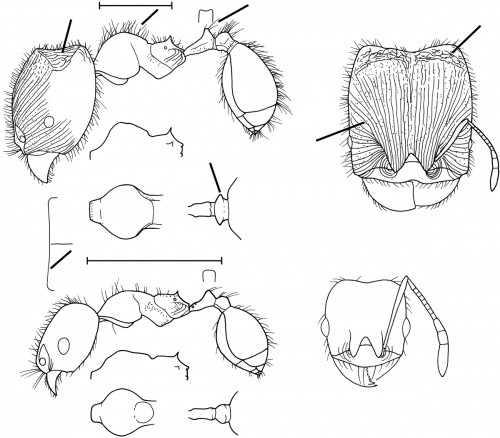Pheidole setsukoae
| Pheidole setsukoae | |
|---|---|
| Scientific classification | |
| Kingdom: | Animalia |
| Phylum: | Arthropoda |
| Class: | Insecta |
| Order: | Hymenoptera |
| Family: | Formicidae |
| Subfamily: | Myrmicinae |
| Tribe: | Attini |
| Genus: | Pheidole |
| Species: | P. setsukoae |
| Binomial name | |
| Pheidole setsukoae Wilson, 2003 | |
Robert J. Hamton (in litt. 1990): the majors and minors were foraging in a single file to dead moths at a blacklight (ultraviolet light used to attract insects). (Wilson 2003)
Identification
See the description in the nomenclature section.
Keys including this Species
Distribution
Only known from the type locality.
Latitudinal Distribution Pattern
Latitudinal Range: 25.344928° to 25.344928°.
| North Temperate |
North Subtropical |
Tropical | South Subtropical |
South Temperate |
- Source: AntMaps
Distribution based on Regional Taxon Lists
Neotropical Region: Mexico (type locality).
Distribution based on AntMaps
Distribution based on AntWeb specimens
Check data from AntWeb
Countries Occupied
| Number of countries occupied by this species based on AntWiki Regional Taxon Lists. In general, fewer countries occupied indicates a narrower range, while more countries indicates a more widespread species. |

|
Estimated Abundance
| Relative abundance based on number of AntMaps records per species (this species within the purple bar). Fewer records (to the left) indicates a less abundant/encountered species while more records (to the right) indicates more abundant/encountered species. |

|
Biology
Castes
Nomenclature
The following information is derived from Barry Bolton's Online Catalogue of the Ants of the World.
- setsukoae. Pheidole setsukoae Wilson, 2003: 597, figs. (s.w.) MEXICO.
Unless otherwise noted the text for the remainder of this section is reported from the publication that includes the original description.
Description
DIAGNOSIS A member of the pilifera group uniquely distinguished within not just Pheidole but ants as a whole by the phragmotic condition of the occiput of the major, as illustrated. Also distinctive in the major, although not unique, are the lack of hypostomal dentition; the high, smoothly rounded outline of the promesonotum in side view; the dense parallel longitudinal carinulae that radiate from the antennal fossae and antennal lobes to the sides of the head; and the conulate postpetiolar node. The minor is typical of the “bicarinata complex” (see under Pheidole bicarinata).
MEASUREMENTS (mm) Holotype major: HW 1.38, HL 1.54, SL 0.62, EL 0.14, PW 0.76. Paratype minor: HW 0.50, HL 0.54, SL 0.60, EL 0.12, PW 0.30.
COLOR Major: concolorous clear yellow with a very slight orange tinge (“light orange”).
Minor: clear medium yellow; dorsal surface of head slightly infuscated, i.e., dark yellow to light brownish yellow.
Figure. Upper: holotype, major. Lower: paratype, minor. Scale bars = 1 mm.
Type Material
MEXICO: 59 km north of Culiacan, Sinaloa, col. Robert J. Hamton. Museum of Comparative Zoology
Etymology
Named after Barbara Setsuko Hamton.
References
- Wilson, E. O. 2003. Pheidole in the New World: A dominant, hyperdiverse ant genus. Harvard University Press, Cambridge, MA. (page 597, fig. major, minor described)
References based on Global Ant Biodiversity Informatics
- Vásquez-Bolaños M. 2011. Lista de especies de hormigas (Hymenoptera: Formicidae) para México. Dugesiana 18: 95-133
- Wilson, E.O. 2003. Pheidole in the New World: A Dominant, Hyperdiverse Genus. Harvard University Press
